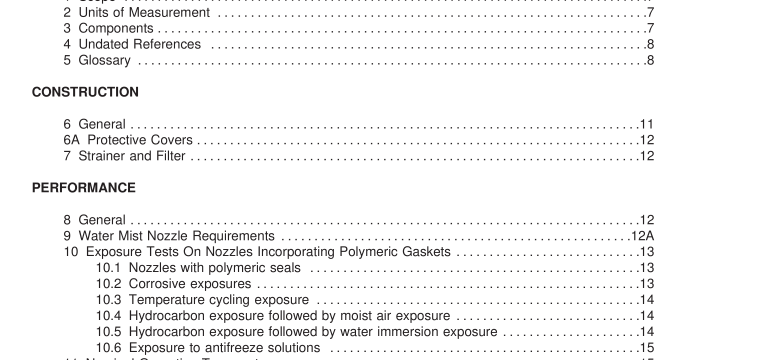UL 2167-2010 pdf download.Water Mist Nozzles for Fire Protection Service.
4 Undated References 4.1 Any undated reference to a code or standard appearing in the requirements of this standard shall be interpreted as referring to the latest edition of that code or standard. 4.1 effective December 27, 2004 5 Glossary 5.1 For the purpose of this standard, the following definitions apply. 5.1 effective December 27, 2004 5.2 CONDUCTIVITY FACTOR – A measure of the conductance between the nozzle’s heat responsive element and the fitting expressed in units of (m/s) 0.5 . 5.2 effective December 27, 2004 5.3 CONTROL SPACES – Shipboard areas such as the bridge, radio room, and emergency power room. 5.3 effective December 27, 2004 5.4 CORROSION RESISTANT MATERIAL – A material (such as bronze, brass, stainless steel, or plastic) which has a low propensity for corrosion when used in its anticipated application. 5.4 effective December 27, 2004 5.5 DESIGN LOAD – The force exerted on the release element at the service load of the nozzle. 5.5 effective December 27, 2004 5.6 ENGINEERED WATER MIST SYSTEMS – A system which requires individual design and calculation to determine the flow rates, nozzle pressures, pipe size, area or volume protected by each nozzle, discharge density, the number and type of nozzles, and the nozzle placement in order to protect a specific hazard. 5.6 effective December 27, 2004 5.7 FIRE CONTROL – Limiting the growth of a fire and controlling ceiling gas temperatures to prevent structural damage. 5.7 effective December 27, 2004
5.8 FIRE SUPPRESSION – The sharp reduction of the heat release of a fire and the prevention of its regrowth. 5.8 effective December 27, 2004 5.9 FLAME SPREAD INDEX (FSI) – A fire spread characteristic measured in accordance with the Standard for Test for Surface Burning Characteristics of Building Materials, ANSI/UL 723. 5.9 effective December 27, 2004 5.1 0 FLASHOVER – A stage in the development of a contained fire in which all exposed surfaces reach ignition temperatures more or less simultaneously and fire spreads rapidly throughout the space. 5.1 0 effective December 27, 2004 5.1 1 FUEL PACKAGE – The combustible materials in which the fire is ignited and also the combustible materials covering the walls and ceiling. 5.1 1 effective December 27, 2004
5.1 2 LIGHT HAZARD AREA – An area where the quantity or combustibility of its contents is low and where fires with low rates of heat release are expected. 5.1 2 effective December 27, 2004 5.1 3 MACHINERY SPACES – Shipboard engine rooms and cargo pump rooms containing combustible or flammable liquids having flammability characteristics no more severe than light diesel oil or heptane. 5.1 3 effective December 27, 2004 5.1 4 NOZZLES – The nozzles covered by this Standard are intended to generate water mist to control, extinguish, or suppress fire and consist of the following types: a) Automatic – A thermosensitive device designed to react at a predetermined temperature by automatically releasing water mist into a designated area or volume. b) Coated – A nozzle which has a factory applied coating for corrosion protection. c) Concealed – A recessed nozzle with a ceiling cover plate. d) Flush – A nozzle in which all or part of the body, including the inlet thread, is mounted above the lower plane of the ceiling. e) Fusible Element – A nozzle that opens under the influence of heat by the melting of a component. f) Glass Bulb – A nozzle that opens under the influence of heat through pressure resulting from expansion of the enclosed fluid. g) Hybrid – A nozzle that opens by the influence of heat or by an independent fire detection system.
h) Multiple Orifice – A nozzle having two or more outlet orifices. i) Open – A nozzle without a thermosensitive element which discharges water mist. j) Pendent – A nozzle that is arranged in such a way that water mist is directed downward by striking a distribution plate or by nozzle orientation. k) Pilot – A heat actuated nozzle which also controls the flow of water to one or more connected nozzles. l) Recessed – A nozzle of which all or part of the body, other than the inlet thread, is mounted within a recessed housing. m) Sidewall – A nozzle which is designed to be installed adjacent to a wall. n) Upright – A nozzle that is arranged in such a way that water mist is initially directed upwards against a distribution plate. 5.1 4 effective December 27, 2004 5.1 5 OPERATING PRESSURE – The pressure at which a nozzle is intended to operate. 5.1 5 effective December 27, 2004.UL 2167-2010 pdf download.
UL 2167-2010 pdf download
